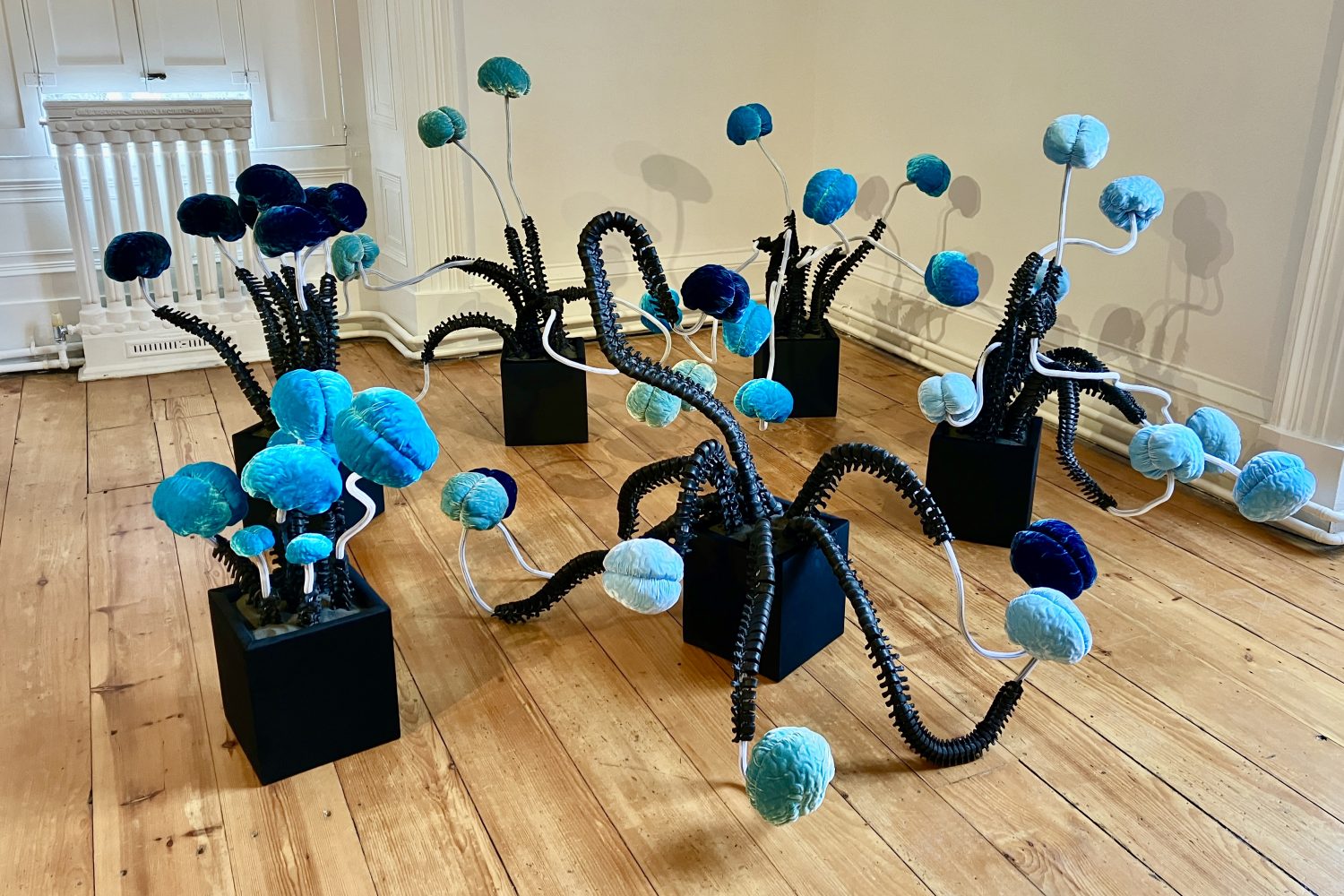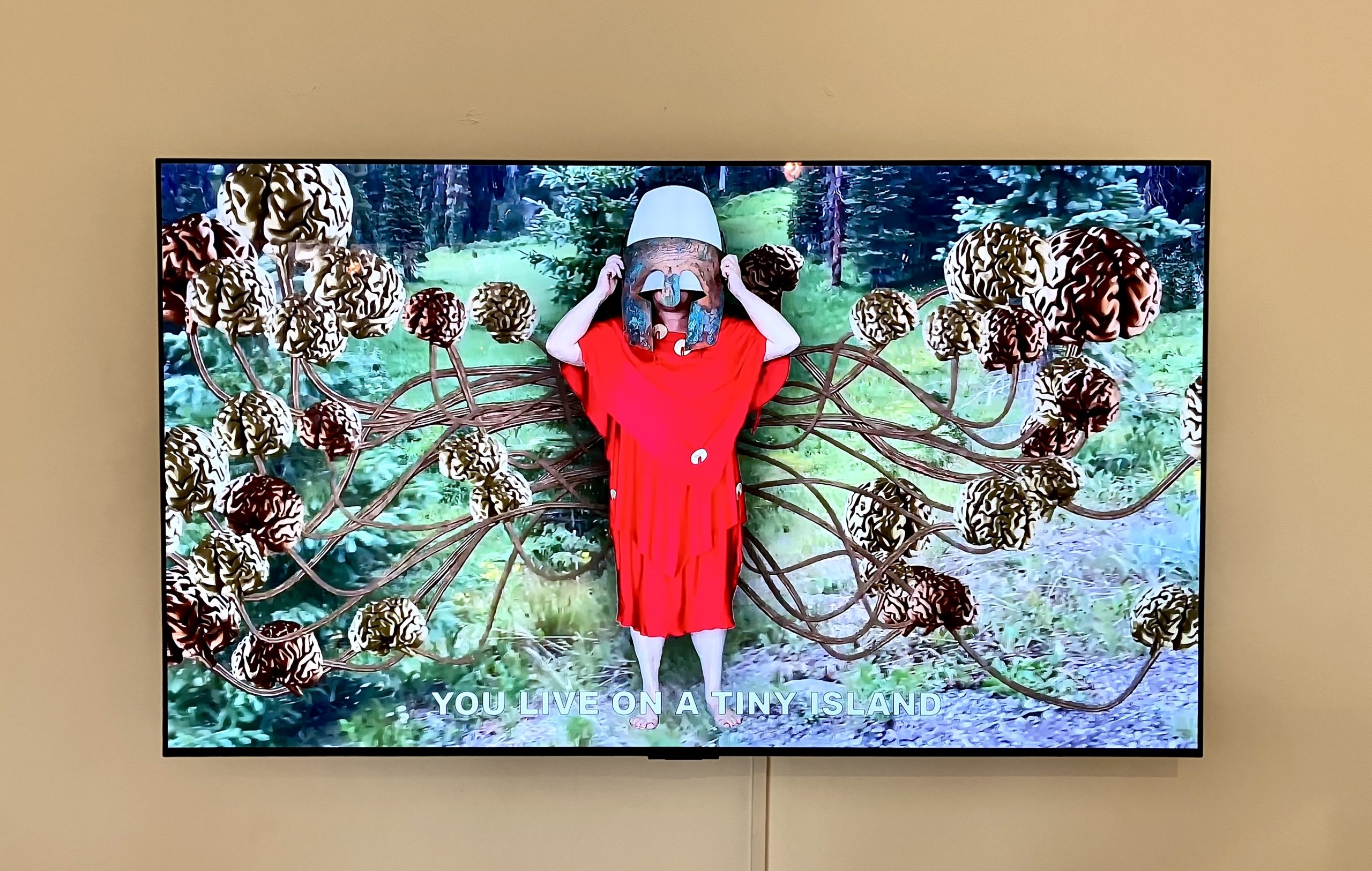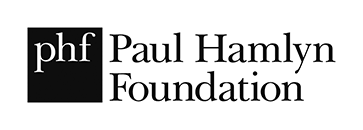Jo Clements at The Whitaker Museum & Art Gallery
by Greg Thorpe
As a space for art, The Whitaker Museum & Art Gallery, set in pretty Rossendale Valley, strikes a satisfying balance between the traditional and contemporary, and brings its responsive and engaged audiences along for the experience. Jo Clements’ current solo show Everyone In This Room Is Connected To Everyone In This Room finds a fitting home at The Whitaker as it similarly seeks to bridge various worlds of analogue/digital, technical/emotional, natural/synthetic, personal/social – and asks in doing so whether these are useful binaries of understanding at all. Spoiler: I think not, and the unravelling and recombining of these impulses is one of the show’s appeals.
Clements’ subject in this collection of new work – which was selected for commission from dozens and dozens of excellent creative submissions – is the human brain, as a subject, object, medium, and metaphor. The theme is certainly immense, and potentially infinite, but Clements’ approach as an artist comes via an applied combination of research and reflection, lived experience and play, all funnelled into an ambitious cross-arts output. As an audience it makes for an experience that is both intimate and intellectual, so frivolity and fine art sit comfortably and closely side by side and make perfect sense. You will find sculpted playful emoji-esque works sharing space with expertly finessed photographs of still-life assemblages that emerge from deep black interiors and borrow their lighting cues from the DutchMmasters. (These particular pieces were produced in collaboration with the photographic artist Bridget Coderec, based at Salford’s Paradise Works). The parts might all be deliberately disparate but the experience is holistic – touching and inspiring.
Two small film works sit side by side and make a valuable starting point for the journey. They reflect upon the artist’s intimate experiences with her parents, and on some of the ways the brain can deceive or diminish – through grief, disease, dementia, decline. The resonance of a circle of carpet as the place where the artist’s mum would stand and gaze into her garden as she grappled with the tumour in her brain is totemic and deeply personal. In fact, the small but very detailed selection of film works in the show are particular playgrounds of association that can be either random or riven with meaning depending on your viewpoint. What could be more brainy? One thing all the works do with marvellous openness is remind us how the brain occupies a space in culture and discourse that is somehow both technical and mystical. The making of the show was itself a valuable learning experience – “Every day there was some kind of technical problem to solve”, says Clements. The human brain is so often made analogous to computers and machines, but it’s the brain itself that makes those incredible creations possible in the first place. The broad expanse of approach and aesthetics in these works both speaks to and celebrates this strange diversity.
As a teenager Clements found her way into a role as a milliner’s apprentice, long before her personal art practice had taken shape, and the skills she learned there come to fruition in multiple pieces in ‘Everyone…’. A centre-piece of assorted velvet brains on elegant wires seems like a beautifully weird artefact from a science-fiction wedding; another arrangement of brains seem to have grown from plant pots like rare thinking orchids, meaty and substantial; and there is the ‘Brain Garden’ which sprouts creature-like brains on spines in a display that is somehow both flora and fauna, apocalyptic but very alive, technically brilliant, bubbling with detail. The spines are “3D printed and anatomically correct”, emerging from sandy black terrain. Clements explains the context:
“If we were wiped out as a species, how could we come back?’ she asks. “There’s nothing to say we couldn’t grow back organically. And if you separate a brain from a body, what does that say about what you are thinking? It’s similar to being online, we don’t see the person, we only really experience what’s in their brain in the moment.”
These pieces can be augmented/animated using your smartphone to activate an additional visual layer in the space which appears spectral and digital on your phone screen. Nothing is static, just as the brain itself is never really still.
For me the overall experience of the works prompted deep questions like: When does the brain become the mind? What does learning feel like? Is experience the same as knowledge? What don’t we know about our brains? There was also a renewed marvelling at things like the plasticity of the brain itself, the formation of personality, and in particular the social currency of knowledge. The works might sometimes be abstract in composition but there is deep political power at play, as there always must be when access to knowledge or learning is at stake. Here, those things are connected to feminism and class and power. Even the brain is not exempt from such things. The artist is present in the work as researcher and needleworker, doctor and daughter, working class kid and professional thinker/maker. The only contradictions are in how society awards/rewards these differing experiences. One can soon appreciate how the brain stands in for so much, placed in the imaginative hands of an artist, hence the show made such a perfect centrepiece for the recent Festival Of The Brain which delved into many of these topics across different disciplines. It’s somehow pleasing to know that art is the chosen forum around which such collective thought can pivot, and in fact the blurring of art and science is another pleasure of the collection.
In navigating the show you might also experience pleasing moments of realisation or sudden connection – this is one of the brain’s many rewards after all – and this deliberately runs through everything from the tendril-like / mycelium-esque sculptural elements (“I might be a frustrated theatre designer!”), to the show’s central provocation of connectivity, to the artist’s own lived/living connections with her family, her practice and her collaborators. The work is thrilling and it’s clever (and why is ‘clever’ sometimes considered pejorative and seldom pleasurable?) and also, but not incidentally, beautiful. The velvet tubes which make up the luscious millinery brains – which you can see being crafted in documentary maker Maria Ruban’s accompanying film – have stayed with me as just one gorgeously tactile memory. Another is the feeling that this is just the beginning of something bigger to come.
If you can choose a day to attend the show I would highly recommend coming on Thursday 20 April when the artist will be in person at the gallery to talk about the work. I was lucky enough to have my own tour of the experience with both Jo and The Whitaker’s Creative Director Gaynor Seville and it added such a vibrant layer of experience that I have been pleasurably mulling over ever since. Come along and be connected.
Everyone In This Room Is Connected To Everyone In This Room exhibits until 7 May.
Jo Clements gives an artist talk at The Whitaker on Thursday 20 April at 7pm.
The Whitaker is open Wed–Sun: 10am–4pm and late night Thursday until 8pm.
Entry is free.
You can read more about Jo Clements here: https://www.joclements.co.uk/
Links:
https://www.thewhitaker.org/whats-on-article/contemporary-art-exhibitions/jo-clements-artist-talk/

















